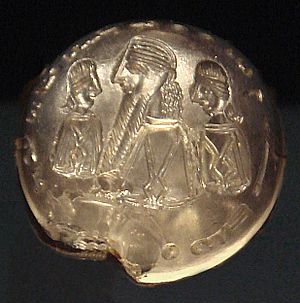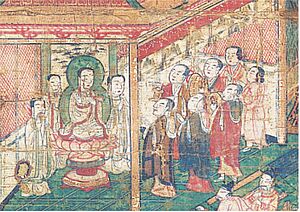Mani (prophet) facts for kids
Quick facts for kids Prophet Mani |
|
|---|---|
| مانی | |

Sealstone of Mani, rock crystal, possibly 3rd century AD, Irak. Cabinet des Médailles, Paris. The seal reads "Mani, messenger of the messiah", and may have been used by Mani himself to sign his epistoles.
|
|
| Religion | Manichaeism |
| Founder of | Manichaeism |
| Personal | |
| Nationality | Iranian |
| Born | c. April AD 216 Ctesiphon, Parthian Babylonia (modern-day Iraq) |
| Died | 2 March AD 274 or 26 February AD 277 (aged 57–58 or 60–61) Gundeshapur, Sasanian Empire (modern-day Iran) |
| Cause of death | Execution by the order of Bahram I |
| Parents | Pātik, Mariam |
| Religious career | |
| Works | Manichaean scripture |
Mani (born around April 216 AD – died March 274 AD or February 277 AD) was an Iranian prophet. He founded Manichaeism, a religion that was very popular in ancient times. This religion was influenced by other beliefs like Gnosticism, Christianity, Zoroastrianism, and Buddhism.
Manichaeism was once widespread across the world. Today, it is mostly found in small parts of China, like Fujian. Mani was born near Seleucia-Ctesiphon in Mesopotamia, which is modern-day Iraq. He wrote most of his important books in Syriac. One book, for the Sasanian emperor Shapur I, was written in Middle Persian. Mani died in Gundeshapur.
Contents
Mani's Life Story
New discoveries in the 20th century have confirmed that Mani was a real person.
Early Years and Visions
Mani was born near Seleucia-Ctesiphon. His father, Pātik, was from Ecbatana (now Hamadan, Iran). He belonged to a Jewish Christian group called the Elcesaites. Mani's mother was from a Parthian family. Her name was Maryam.
Mani grew up in a unique religious community in Babylon. This group had some Gnostic ideas. They believed that heavenly messengers, like a special version of Jesus, would appear again and again. When Mani was 12 and then 24, he had special visions. He saw a "heavenly twin" who told him to leave his father's group. This twin told him to share the true message of Jesus in a new way.
Journeys and Teachings
After his visions, Mani traveled to India. This was in the area of modern-day Afghanistan. There, he learned about Hinduism and Buddhism. Some sources say he went to India after being forced to leave Persia.
Mani returned in 242 AD. He met Shapur I, the Sasanian emperor. Mani gave him his only book written in Persian, called the Shabuhragan. Shapur I did not become a Manichaean. However, he liked Mani's ideas, which blended parts of Christianity, Buddhism, and Zoroastrianism. Shapur I allowed Mani to stay at his royal court.
Mani was also known as a talented painter. People said he could perform miracles, like floating in the air or healing the sick. These stories helped him gain followers among the Iranian leaders.
Imprisonment and Death
Shapur's son, Hormizd I, ruled for only one year. He also supported Mani. But the next king, Bahram I, was a strong follower of Zoroastrianism. Bahram I started to persecute, or punish, the Manichaeans.
King Bahram I put Mani in prison. Mani died there within a month, in 274 AD. Sources say he spent his last days comforting his students. He taught them that his death would simply be his soul returning to a place of light. Mani's followers believed his death was like the crucifixion of Jesus.
Mani's Writings
Mani wrote six books in Syriac and one in Persian, called the Shapuragan. None of his original books have survived completely. However, we have many pieces and quotes from them. These fragments are found in languages like Middle Persian and Coptic.
Some parts of his works that still exist include:
- The Shabuhragan (in Middle Persian).
- The Book of Giants (many pieces in different languages).
- The Fundamental Epistle (a long quote from it was used by Saint Augustine).
- Parts of his Living Gospel.
- His Letter to Edessa, found in the Cologne Mani-Codex.
Mani also wrote a special book called Arzhang. This holy book of Manichaeism was unique because it had many drawings and paintings. These pictures helped explain the Manichaean ideas about how the world was created and its history.
Mani's Teachings
Mani wanted his teachings to be a new, better version of other religions. These included Christianity, Zoroastrianism, Buddhism, and Gnostic movements. His religion was based on a strong idea of dualism. This means he believed in two main forces: good and evil, always fighting each other.
In his mid-twenties, Mani decided that people could find salvation. This could happen through learning, self-control, fasting, and living a pure life. Mani claimed to be the Paraclete (a helper or comforter) mentioned in the New Testament. He also saw himself as the Last Prophet.
Mani called himself an "apostle of Jesus Christ." Manichaean poems often praise Jesus and his mother, Mary. Manichaean tradition also taught that Mani was a new form of important religious figures. These included Jesus, Zoroaster, and the historical Buddha.
Mani's followers were organized like a church. They had two main groups: "elects" (electi) and "auditors" (auditores). Only the electi had to follow the rules very strictly. The auditores helped the electi. They hoped to become electi themselves after reincarnation.
Images for kids
-
Painter Mani presenting king Bukhram-Gur (Bahram) with his drawing. 16th-century painting by Ali-Shir Nava'i, Shakrukhia (Tashkent).
-
Statue of Mani in the Cao'an temple, China.
See also
 In Spanish: Mani para niños
In Spanish: Mani para niños






